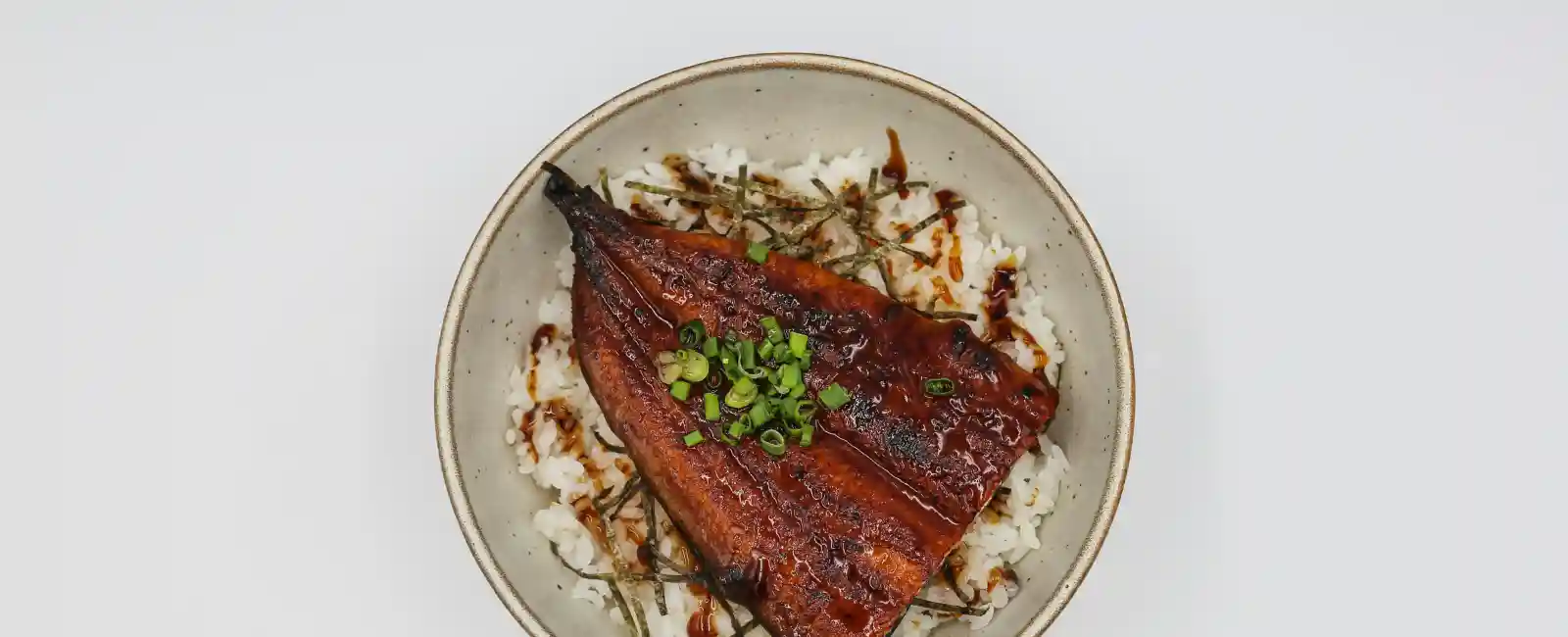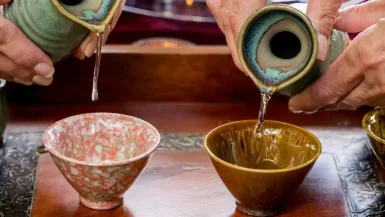Japan’s culinary landscape is as diverse as its seasons, offering a tantalizing array of flavors that change with the time of year. The concept of shun, or seasonality, is deeply rooted in Japanese culture. This concept nowhere is more evident than in the country’s food. Each season brings its own unique delicacies, from the fresh produce of spring to the hearty dishes of winter. This guide will take you through Japan’s seasonal delicacies, highlighting the must-try foods that capture the essence of each time of year.
Japan’s chefs embrace seasonality to create dishes that reflect the natural beauty of each season. Spring’s ingredients burst with fresh, vibrant flavors. Summer brings light, refreshing dishes to combat the heat. Autumn introduces rich, earthy tastes that celebrate the harvest. Winter offers warm, comforting foods that nourish the soul during the cold months.
Spring: A Celebration of Fresh Beginnings
Sakura mochi
Spring in Japan is synonymous with cherry blossoms.This season also brings a bounty of fresh ingredients that define Japan’s seasonal delicacies. One of the most iconic springtime treats is sakura mochi. It’s a sweet rice cake wrapped in a pickled cherry blossom leaf. This delicacy not only symbolizes the beauty of the cherry blossoms but also offers a unique blend of sweet and salty flavors. As you bite into the soft mochi, the fragrance of the cherry blossoms transports you to a tranquil Japanese garden in full bloom.
Takenoko
Another spring delicacy you must try is takenoko, or bamboo shoots. Harvested in early spring, takenoko features prominently in various dishes, from soups to stir-fries. Its crisp texture and subtle earthy flavor make it a favorite in Japanese cuisine during this season. Often served with wakame (seaweed) in a light broth, this dish epitomizes the simplicity and elegance of springtime dining.
Sansai
Sansai (wild mountain vegetables) also make their appearance in spring. These vegetables, such as fiddlehead ferns, udo (Aralia cordata), and fuki (butterbur), are foraged from the mountains and add a touch of bitterness to balance the flavors of other dishes. Many Japanese restaurants offer a special sansai menu in spring. It is allowing diners to experience the full range of these unique ingredients.
Ichigo daifuku
To complete your spring culinary journey, indulge in ichigo daifuku. This dessert consists of a plump strawberry enveloped in sweet red bean paste and soft mochi. The freshness of the strawberry pairs perfectly with the sweetness of the bean paste, making it a beloved springtime treat. As the weather warms and the cherry blossoms fall, the delicate flavors of spring offer a refreshing start to the year. The contrast between the juicy strawberry and the soft, chewy mochi creates a delightful texture that melts in your mouth. Each bite of ichigo daifuku encapsulates the essence of spring, with its vibrant colors and harmonious balance of flavors. This seasonal delicacy not only satisfies your sweet tooth but also celebrates the fleeting beauty of Japan’s springtime.
Summer: Refreshing Flavors for Hot Days
Somen
As the temperatures rise, Japan’s seasonal delicacies shift to lighter, more refreshing flavors to combat the summer heat. One of the most popular summer dishes is somen, thin wheat noodles served cold with a dipping sauce. The simplicity of somen makes it a perfect dish for hot summer days. The noodles are often garnished with fresh ginger, green onions, and myoga (Japanese ginger). In some regions, you can even experience nagashi somen. In this dish the noodles flow down a bamboo chute, and diners catch them with chopsticks. It’s a fun and interactive way to enjoy this summer delicacy.
Unagi
Another summer favorite is unagi, or grilled eel. Unagi is traditionally eaten during the hottest days of summer, known as Doyo no Ushi no Hi, to restore energy and vitality. The eel is grilled over charcoal and glazed with a sweet soy-based sauce, giving it a rich, smoky flavor. Served over a bed of rice, this dish is both hearty and satisfying, making it a staple of Japan’s summer cuisine.
Hiyayakko
Hiyayakko is often served as a starter in summer meals, providing a refreshing contrast to heavier dishes. The simplicity of the ingredients allows the quality of the tofu to shine, making it essential to use the freshest tofu available. Paired with a glass of chilled sake, this dish embodies the essence of Japan’s seasonal delicacies, offering both nourishment and a sense of calm during the hottest months.
Momo
Summer in Japan also brings an abundance of fresh fruits, with momo (peach) being one of the season’s highlights. Japanese peaches are incredibly juicy and sweet, with a delicate fragrance that is simply irresistible. Whether enjoyed on their own or used in desserts like peach parfaits, this fruit embodies the essence of summer’s bounty.
Kakigori
Finally, don’t miss out on kakigori, Japan’s version of shaved ice. This iconic summer treat comes in various flavors, from traditional matcha and red bean to more modern options like mango and strawberry. Topped with condensed milk or syrup, kakigori is not just a dessert but a refreshing way to beat the heat. As you savor each spoonful, you’ll understand why this simple treat remains a beloved part of Japan’s seasonal delicacies.
Autumn: A Harvest of Rich Flavors
Matsutake
Autumn in Japan is a time of abundance, with the harvest bringing a variety of ingredients that contribute to the richness of Japan’s seasonal delicacies. One of the most celebrated autumn foods is matsutake, a highly prized mushroom known for its robust, earthy aroma. Matsutake are often grilled, steamed with rice, or used in soups to enhance their natural flavors. The mushroom’s scarcity and the difficulty of harvesting it make matsutake a luxury item, often enjoyed in special meals that celebrate the bounty of autumn.
Kabocha
Another autumn delicacy is kabocha, or Japanese pumpkin. This versatile vegetable appears in various dishes, from soups to tempura. Its sweet, nutty flavor and creamy texture make it a comforting addition to autumn meals. Kabocha is often simmered in a dashi-based broth, allowing its flavors to meld beautifully with the umami-rich stock. This simple preparation highlights the pumpkin’s natural sweetness, making it a staple of autumn cuisine. In addition to savory dishes, kabocha is also used in desserts, such as kabocha purin (pumpkin pudding), where its rich texture and subtle sweetness shine through. Its vibrant orange color adds a festive touch to any meal, making kabocha a beloved ingredient as the weather cools. For many, the arrival of kabocha on menus signals the true beginning of autumn in Japan, bringing warmth and comfort to the table.
Sanma
Sanma’s popularity during autumn also stems from its peak seasonality, when the fish is at its fattiest and most flavorful. In Japanese households, the simple preparation of grilling sanma allows the natural oils to seep out, creating a crispy skin while keeping the inside tender and juicy. This seasonal delicacy is often accompanied by a squeeze of citrus, such as sudachi or yuzu, which enhances the fish’s umami and provides a bright, tangy finish to each bite.
Kuri
Chestnuts, or kuri, also play a significant role in autumn cuisine. Kuri-gohan, or chestnut rice, is a traditional dish where chestnuts are cooked with rice, creating a sweet and savory flavor that is both satisfying and warming. Chestnuts also find their way into desserts, such as mont blanc, a popular pastry that combines chestnut puree with whipped cream.
Kaki
No discussion of autumn delicacies would be complete without mentioning persimmons or kaki. This sweet, orange fruit can be enjoyed fresh, dried, or even used in cooking. Dried persimmons, known as hoshigaki, offer a chewy texture and concentrated sweetness that make them a popular snack during the autumn months. Whether you enjoy them as part of a dessert or simply on their own, persimmons capture the essence of Japan’s autumn harvest. In addition to their delicious taste, persimmons are also celebrated for their nutritional benefits, being rich in vitamins A and C. The fruit’s vibrant color and naturally sweet flavor make it a popular ingredient in seasonal dishes, from salads to baked goods. As you explore Japan’s seasonal delicacies, don’t miss the chance to savor the distinct and delightful flavors of kaki during autumn.
Winter: Comfort Foods for Cold Days
Nabe
Winter in Japan brings a desire for warmth and comfort, reflected in the hearty dishes that define Japan’s seasonal delicacies during this season. One of the most beloved winter dishes is nabe, or hot pot. Nabe involves cooking a variety of ingredients—such as meat, tofu, and vegetables—in a bubbling pot of broth, right at the table. The communal nature of nabe makes it a perfect dish for gathering with family and friends during the cold winter months. Variations like yosenabe (mixed hot pot) and shabu-shabu (thinly sliced meat cooked in hot broth) offer different experiences, but all provide the warmth and comfort essential to winter dining.
Yakiimo
Another winter specialty is yakiimo, or roasted sweet potatoes. Yakiimo are often baked in wood-fired ovens, which gives them a smoky, caramelized flavor that is simply irresistible. The sweet, creamy interior of the potato contrasts beautifully with its crispy skin, making it a perfect snack to warm your hands and heart on a chilly day. The aroma of yakiimo wafting through the air. It is a familiar and comforting scent in Japanese winter, drawing people to the warmth of the vendors’ stalls. Enjoying a hot yakiimo while strolling through a winter festival or on a quiet evening walk is a cherished tradition that connects you to the season’s simple pleasures. This humble snack embodies the essence of Japan’s winter delicacies, offering both nourishment and nostalgia in every bite.
Oden
Oden is another quintessential winter dish. This slow-simmered stew features various ingredients, such as daikon radish, boiled eggs, fish cakes, and tofu, all cooked in a soy-flavored broth. Each bite of oden offers a different texture and flavor, from the tender daikon to the chewy fish cakes. Oden is often sold from food carts or convenience stores. The rich, savory broth warms you from the inside out, making it a favorite among locals and visitors alike. Many regions in Japan have their own unique variations of oden, adding local ingredients and flavors to this beloved dish. Enjoying a steaming bowl of oden on a cold winter’s evening encapsulates the essence of Japan’s seasonal delicacies.
Fugu
Lastly, winter is the season for fugu, or pufferfish. Fugu is a delicacy that requires careful preparation due to its potentially deadly toxins. However, when prepared by a skilled chef, fugu offers a delicate, slightly chewy texture that is prized by gourmets. Often served as sashimi or in a hot pot, fugu is a luxurious way to experience the flavors of winter in Japan. The preparation process itself is an art form, with chefs undergoing rigorous training and certification to handle this fish safely. This meticulous care ensures that every slice of fugu is not only safe to eat but also a masterpiece of flavor and texture. For those seeking a truly unique and refined dining experience, fugu represents the pinnacle of winter cuisine in Japan.
Conclusion: A Year-Round Culinary Adventure
Japan’s seasonal delicacies offer a culinary journey that reflects the changing landscapes and traditions of the country. Each season brings its own unique ingredients and flavors, allowing you to experience the essence of Japan through its food. From the fresh, vibrant tastes of spring to the rich, comforting dishes of winter, Japan’s cuisine is a celebration of seasonality and the art of enjoying each moment to the fullest.
As you explore Japan’s seasonal delicacies, you’ll discover that every bite tells a story—of the land, the people, and the culture that have shaped these traditions over centuries. Whether you’re savoring the delicate sweetness of sakura mochi in the spring or the comforting warmth of nabe in the winter, you’ll find that each dish is a reflection of Japan’s deep connection to its seasons. These flavors not only nourish the body but also offer a profound sense of place and tradition.
Explore more about Local Snacks and Sweets in Japan in this article.




